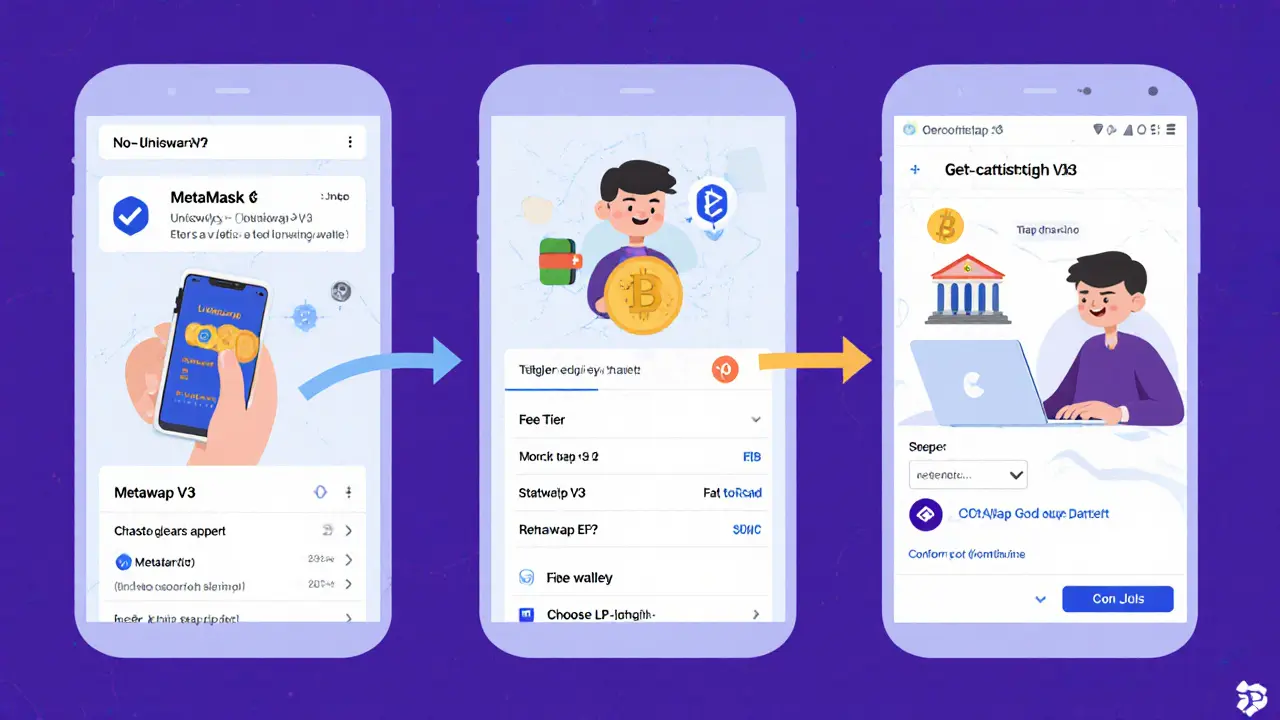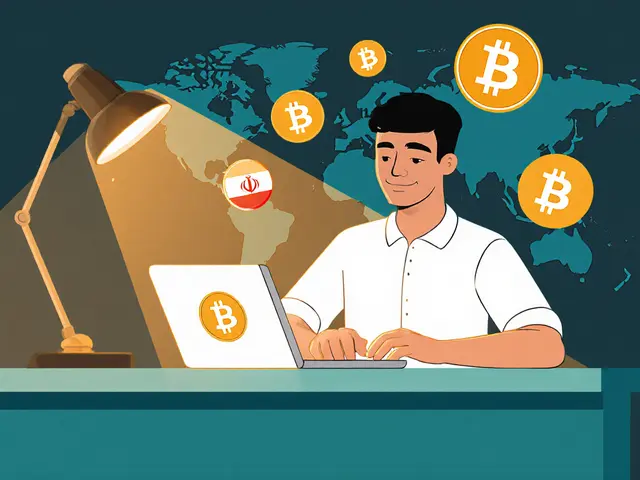TOAD (TOAD) Crypto Coin Explained: Supply, Price, Risks & How to Trade
Discover what TOAD (TOAD) crypto coin is, its supply, price, risks, and how to trade it on Solana. Get a clear, practical guide for short‑term speculation.
Read More

Estimate your potential earnings from providing liquidity in Uniswap V3 based on your token amounts, fee tier selection, and expected trade volume. This calculator is designed for educational purposes only and does not guarantee real-world returns.
Note: This calculator uses simplified assumptions. Actual earnings may vary significantly based on market conditions, impermanent loss, and network congestion.
Enter values above to see your potential earnings.
Daily Earnings (in Token A)
-
Monthly Earnings (in Token A)
-
Total Value of Position
-
Fee Tier Comparison
Select a fee tier to see comparison
This calculator is designed for educational purposes only and does not account for:
Liquidity provision carries risks including impermanent loss. Always do your own research and only provide liquidity with funds you can afford to lose.
Uniswap V3 is a decentralized exchange (DEX) built on Ethereum that lets users swap ERC‑20 tokens directly from their wallets. Launched in May 2021, Uniswap V3 introduced concentrated liquidity, multiple fee tiers and NFT‑based LP positions, reshaping how liquidity providers earn fees. This Uniswap V3 review walks through the core features, costs, pros and cons, and shows you how to start trading or providing liquidity.
Uniswap V3 runs entirely on smart contracts, meaning there’s no central authority, no custodial accounts and no order book. Users connect a non‑custodial wallet such as MetaMask or Trust Wallet, select a token pair, and hit “Swap”. The protocol automatically routes the trade through the deepest pool available, delivering near‑instant settlement.
At its heart, Uniswap V3 is an Automated Market Maker (AMM). Liquidity providers (LPs) deposit two assets into a pool and receive a unique NFT that represents their custom price range. Unlike V2, where liquidity is spread across the entire price curve, V3 lets LPs concentrate capital where they expect most trades, improving capital efficiency by up to 4‑10×.
Uniswap V3 offers four fee tiers: 0.01 %, 0.05 %, 0.30 % and 1 %. The tier you choose depends on the volatility of the token pair and how much you want to earn versus how much risk you’re willing to take. In practice, the 0.30 % tier dominates most liquid pairs (e.g., ETH/USDC). Compared with centralized platforms like Coinbase, which charge up to 0.60 % on small orders, Uniswap’s on‑chain fees are generally lower.
However, gas fees on the Ethereum mainnet can spike dramatically. During peak congestion, a simple swap can cost $15‑$30 in gas. To avoid this, many traders move to layer‑2 networks such as Polygon or Optimism, where the same trade drops to a few cents.

Concentrated liquidity is the headline feature of V3. When you add liquidity, you set a lower and upper price bound. If the market stays within that range, your capital works harder and you earn higher fees. If the price moves outside, your capital sits idle and you earn nothing until you rebalance.
Because each position is an NFT, you can trade or transfer it just like any other token. This also means you can use secondary marketplaces to sell a profitable LP position without withdrawing the underlying assets.
Uniswap V3 supports thousands of ERC‑20 tokens, from major assets like ETH, USDC, DAI, and WBTC to niche DeFi projects. The breadth of listings means you can access emerging tokens without leaving the platform, a clear advantage over centralized exchanges that need lengthy listing processes.
| Feature | Uniswap V3 | Coinbase (CEX) | SushiSwap (DEX) |
|---|---|---|---|
| Token variety | Thousands of ERC‑20 | Limited to listed assets | Thousands, similar to Uniswap |
| Fee tiers | 0.01 % - 1 % | Flat 0.30 % - 0.60 % | 0.05 % - 0.30 % |
| Gas cost (Ethereum mainnet) | Variable, high during peaks | None (off‑chain) | Same as Uniswap |
| Liquidity efficiency | High (concentrated liquidity) | High (order‑book depth) | Standard AMM |
| Regulatory exposure | None - fully permissionless | KYC/AML required | None - permissionless |
The table shows why many traders prefer Uniswap for access and fee flexibility, while still acknowledging the higher gas cost on Ethereum.

Tip: If gas feels too high, switch the network selector to Polygon or Optimism before swapping.
Uniswap V3 remains a cornerstone of DeFi, but the platform is already looking ahead to V4 enhancements like hook‑enabled custom pools. With Ethereum’s roadmap toward sharding and continued L2 adoption, gas costs are expected to drop, making V3’s superior capital efficiency even more attractive. Keep an eye on the UNI token governance proposals-changes to fee structures or incentive programs can directly affect your returns.
Uniswap V3’s code has been audited by multiple firms and runs on immutable smart contracts. While no protocol is 100 % risk‑free, the open‑source nature lets anyone verify the logic. The biggest risks are smart‑contract bugs and impermanent loss for liquidity providers.
Trade on layer‑2 networks (Polygon, Optimism), bundle multiple swaps into a single transaction, or trade during off‑peak hours (usually early UTC mornings). Some wallets also let you set a custom gas price.
Impermanent loss occurs when the price ratio of the two tokens you deposited shifts away from the range you set. Your LP position may be worth less than simply holding the tokens, but fees earned can offset that loss over time.
No. Uniswap V3 only supports ERC‑20 assets on Ethereum and compatible L2s. To trade non‑ERC‑20 assets you need a bridge or a different DEX that runs on the native chain.
UNI is the governance token. UNI holders can vote on fee tier adjustments, reward programs, and protocol upgrades. While UNI doesn’t affect individual swaps, governance decisions can change the overall fee landscape.
This whole thing is just overcomplicated. Why not just use Binance? Simple. Fast. No gas fees. 🤷♂️
Oh honey, you’re using Uniswap V3? How adorable. I’ve been deploying concentrated liquidity on Arbitrum with custom hooks since last winter. You’re still on Ethereum mainnet? 😅 I mean, it’s cute that you think gas is ‘high’ - it’s just the price of being a real DeFi degens. 🥂
I just started with Uniswap V3 last week and honestly? It’s kinda magical. I set my price range for ETH/USDC and now I’m earning fees just by holding. Feels like passive income magic. 🌟
u shud try using balancer or curve for stablecoins. uniswap v3 is good but u need to monitor ur positions every day or u lose money. also gas on eth is a scam. use polygon. i lost 200$ last month bc i forgot to rebalance. lol
In Nigeria, we call this 'financial sovereignty.' To trade without permission from a bank or government - this is liberation. Uniswap V3 is not just a DEX; it is a declaration of economic independence. The gas fees? A small price to pay for freedom. 🇳🇬
You think you're earning fees. You're just gambling with impermanent loss. Most LPs lose. The system is designed to extract value from the naive.
Look, I’ve been in crypto since 2017. I mined Bitcoin on my laptop. I held through the 2018 crash. I watched every single DeFi summer collapse. And let me tell you - Uniswap V3 is not revolutionary. It’s just a rebrand of what Curve did in 2020. Concentrated liquidity? That’s just limit orders with extra steps. And don’t even get me started on NFT LP positions - it’s just another way to inflate the NFT bubble. The real innovation is in ZK-rollups, not in making liquidity providers babysit their positions like it’s a toddler. You’re all just chasing yield like lemmings. The real alpha is in building on L3s, not optimizing fee tiers on L2s. And don’t even get me started on UNI governance - it’s a democracy for whales. You think your vote matters? It doesn’t. The top 10 wallets hold 40% of the supply. Wake up.
I tried V3 once. Got slapped with $22 in gas for a $50 swap. Never again. I use Coinbase. Same tokens, no headaches. Why do people make this so complicated?
Just did my first LP position on Polygon 🚀 and earned $18 in fees in 3 days 😍 no gas stress, just chill vibes. DeFi is finally becoming fun again 💪
If you're new to this, don't stress. Start small. Use Polygon. Watch how the price moves. Rebalance once a week. You don't need to be a wizard. Just be patient. We've all been there.
You think you’re smart for using concentrated liquidity? Most LPs are just feeding the protocol. The real winners are the arbitrage bots. You’re the meat. The gas fees? That’s your tax for being gullible.
There’s a quiet poetry in liquidity provision. You’re not just trading tokens - you’re anchoring value in a decentralized world. The price range you set becomes a silent vote for where you believe the market should be. It’s not about profit. It’s about participation. And in that, even the losses carry meaning.
I get it - gas is rough. But if you're just starting out, maybe try a small position first? Don't put in more than you're okay losing. I've seen too many people burn out because they went all in too fast. Take it slow. You've got time. 🙏
Uniswap V3? More like Uniswap V3: The Gas Tax Simulator. You're not providing liquidity - you're paying to be a beta tester for DeFi's most overengineered dumpster fire. And don't even get me started on NFT LP positions - that's just NFT speculation wrapped in a whitepaper. This isn't finance. It's a casino with a blockchain sticker.
The fee tiers are smart, but the UX is still a nightmare. I’ve spent more time reading docs than actually trading. And the lack of native fiat on-ramp? Still a massive barrier for normal people. Solid tech, terrible onboarding.
Use polygon no gas problem easy to use
You know what’s funny? Everyone says 'use Polygon' like it's the holy grail... but then they come back a month later crying because their LP position got frontrun by a bot on L2. The real problem isn't gas - it's that we're all pretending this is stable when it's not. 🤷♂️

Discover what TOAD (TOAD) crypto coin is, its supply, price, risks, and how to trade it on Solana. Get a clear, practical guide for short‑term speculation.
Read More
Explore how Nigeria's crypto ban sparked a massive underground P2P market, the platforms that powered it, its economic impact, and what the future holds.
Read More
A 2025 guide listing crypto exchanges that still accept Iranian users, covering domestic options, international platforms, fees, security, and recent regulations.
Read More
Comments (17)